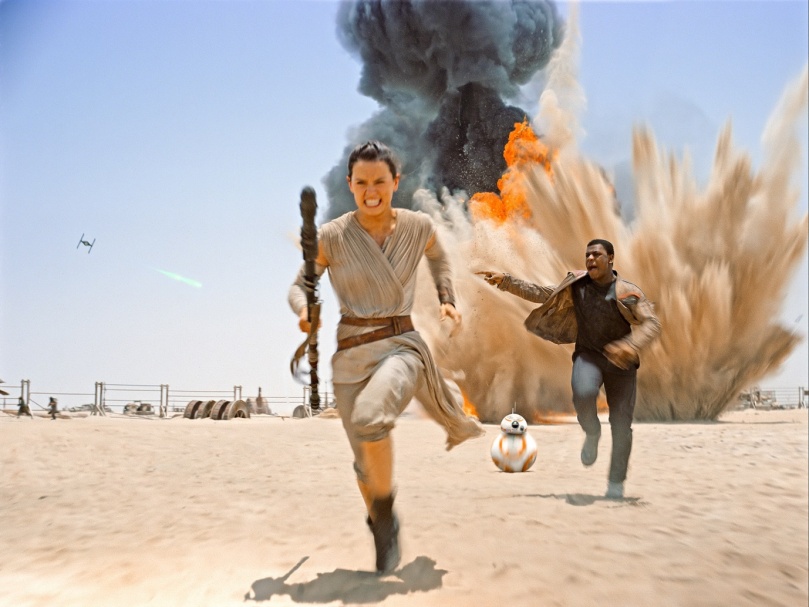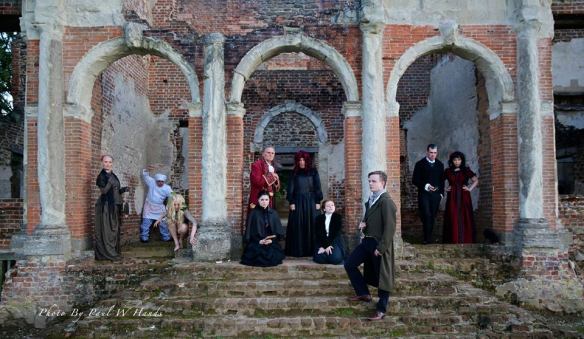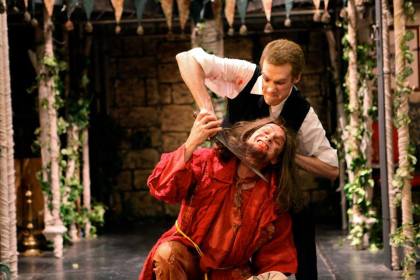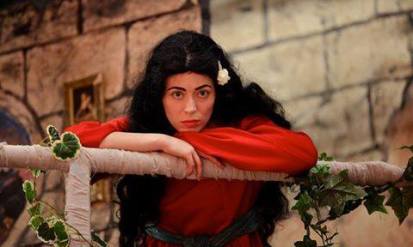The Force Awakens marks the beginning of a new era of Star Wars, without losing the feel of the old one

spoilers ahead: a spoiler-free version was originally published on amelioratemag.com
I’d been looking forward to this film since it was first announced. My family are hard-core Star Wars fans; I’ve watched all three films more times than I can count, and we had our tickets booked over a month ago. I’m part of the generation that thinks the ewoks are kind of cute, which means I never got to see the original Star Wars films in the cinema, and so, on top of everything else, this was a first time for me.
The Force Awakens begins with the trademark rolling credits and from the first scene – a fight against the First Order regime on the planet of Jakku – it feels like coming back to an old friend. It’s true that JJ Abrams has played it safe with this film, but I think this was a wise move and means that it feels completely immersed in the Star Wars universe. There is just the right balance of new against old, and The Force Awakens is a natural, albeit dark, continuation of the original trilogy.
The two heroes, Rey and Finn (Daisy Ridley and John Boyega) carry a lot of the film, and do so very well. Their dynamic is sweet and believable, and it’s easy to root for them as individuals and as a pair. Rey is a compelling heroine, reminiscent of Luke Skywalker in A New Hope, which is furthered by her connection to the force. Boyega is funny and likeable as Finn, although we don’t get a lot of explanation of his back story. We see the film through their eyes, as characters for whom Han, Leia and Luke are stories they might have heard as children, oddly similar to a fan’s perspective. The journey that both Rey and Finn go through is well-balanced with the presence of Han, Leia and other recognisable characters – there is never too much focus on their lack of knowledge, to the point of become annoying exposition, but enough to make their development and conflicts consistent. One of the best things about the original Star Wars movies was the strength of the characters, and the first movie sets Rey and Finn up very well to take even larger roles in the following films.

If you’re a female sci-fi fan, you’ve probably grown up idolising Princess Leia, as one of the few standout female characters from the sci-fi canon (otherwise populated by mostly white men). Therefore it feels fitting that a modern Star Wars should have a female lead, and Rey is a Princess Leia for the 21st Century, far from a token “strong female character.” She is allowed self-doubt, excitement, resourcefulness, vulnerability, and force-sensitivity – while Finn, one of Sci-Fi’s first black male leads, gets to be a lightsaber-wielding run-away Stormtrooper. John Boyega had one of the best responses in the world when “fans” threatened to boycott the movie because his character was black: “they’re stupid, and I’m not going to lose sleep over people.” With Star Wars VII we got the diversity we deserved all the way back in the first movie, which is summed up for me in the moment where Rey and Finn celebrate their respective piloting and shooting skills, after stealing the Millennium Falcon from Jakku and evading the First Order. For some reason this meant something to me: it was two people being allowed to express confidence and excitement in their own success, something we so rarely see from anyone other than white men.
There are a lot of parallels between this film and the original trilogy, right down to BB-8, Rey’s robot sidekick. These are hardly unintentional and give me confidence that JJ Abrams knew what he was doing with this film. Star Wars villains are some of the best villains out there, because they are so flawed and fallible, and The Force Awakens’ masked villain (with a connection to the main characters) is no exception. Rey fits the Luke mould as an unlikely hero brought up away from her family, and Finn is a softer version of Han Solo – the outsider who doesn’t quite fit in. The officers of the New Order are as sinister and British as those of the Empire, and the older characters are the Obi-Wan and Yoda of this trilogy.

I’m not good at watching movies: I prefer the shorter instalments of TV shows, and I don’t like sitting through several hours of something without a break. Good movies are always an exception, and The Force Awakens was one of them – trust me, it means a lot when I say that my eyes never left the screen. And although I’ve been informed by my post-movie internet research that there are plot holes, they didn’t impact my enjoyment of the movie at all.
There are certainly some things that need explanation, and some things that are very intentionally left in the dark. Rey’s identity – by which I mean her parentage – is a big one. It’s very likely that she is either Luke or Leia’s daughter, from her force-sensitivity. If she is Han and Leia’s child, that would draw an interesting parallel from the expanded universe canon, where Han and Leia have a twin boy and girl, Jacen and Jaina – and Kylo Ren is a close fit to Jacen Solo, who turns evil in the novels. It doesn’t explain why neither Leia nor Han would know who she is, although if she was sent away as a child, around the time Ben Solo/Kylo Ren turned to the Dark Side, it is conceivable that they either don’t know or don’t want her to know. The leader of the First Order, Snoke, is in dire need of a backstory, or at least some explanation for who he is, why he came to power and what he wants. I’d also be interested to know, although this doesn’t need an explanation, what separates Finn from the rest of the Stormtroopers (he’s unlikely to be related to anyone, since the only prominent black character in the original trilogy was Lando Calrissian) and why the First Order uses young children instead of clones, as the Empire did.

Film has a tendency to immortalise, and there was something very bittersweet about seeing the characters grown up and wearied by the world. Carrie Fisher described her character as “feeling somewhat defeated, tired, and pissed,” and there’s definitely more than a hint of sadness to both Leia (now a general) and Han Solo when we meet them, suggesting that the years after Return of the Jedi haven’t been easy for either of them. We see them reunite, and it is very sweet, but a part of me wants to go on believing that they all got their happily ever after. The big spoiler is of course the fact that Han Solo is killed by his son, Kylo Ren, near the end of the movie, and while his death felt oddly fitting (and, if you’re Harrison Ford, was way overdue) I do feel sad that he and Leia never got to properly reconcile. At least we’ll get to see Luke in 2017…
The Force Awakens was a strong beginning to the final instalment in the Star Wars franchise. The film is visually stunning and has a very similar feel to the original movies, which meant that watching it was properly exciting; a moment-by-moment discovery of what was happening 32 years after the events of Return of the Jedi. I urge you to go and see it, although if you haven’t seen the original trilogy, you’ll miss out on a lot of the references and, possibly, the enjoyment. Nevertheless, I don’t think I could have asked for a better Episode VII – I was well-prepared for disappointment when I walked into the cinema, and I came out with the opposite.



